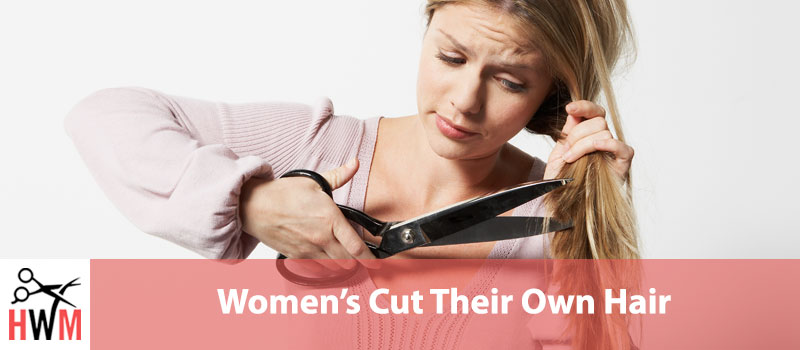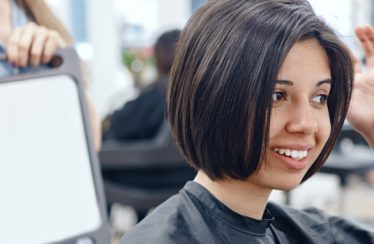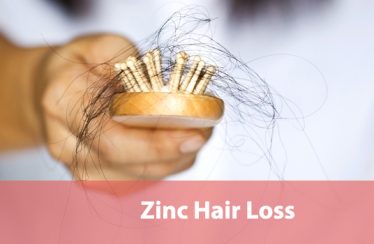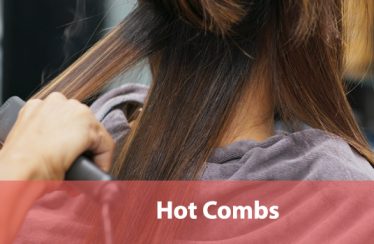With the way the world has changed in recent months, going out to a salon for a haircut is no longer a simple exercise. Even if you’re not under quarantine or your city hasn’t been locked down, close contact with other people is a risky business. This is why so many people are choosing to cut their hair at home.
However, cutting hair at home is easier for men than for women. This is mainly because the technique for cutting men’s hair is easier and the margin for error wider. In contrast, women’s haircutting techniques tend to be more complicated and mistakes more punishing.
So, even if you’re making sure to cut your sons’ and husband’s hair at home, you’re probably feeling apprehensive about giving yourself a haircut. Our advice to you is simple, ‘don’t. While intimidating at first glance, cutting your hair at home will stop looking difficult if you break it down to smaller tasks.
What’s more, is that you’ll have multiple haircutting techniques to pick from. We’ve laid out everything for you in simple terms on this page so that you can perform the task with ease, surety, and without making any mistakes. Here’s everything you’ll learn in this comprehensive guide to cutting your own hair.
- Do You Need to Cut Your Own Hair at Home?
- How to Prepare for Cutting Your Own Hair
- Cutting the Hair at Home
Do You Need to Cut Your Own Hair at Home?
There are two aspects to this question. The first is whether you should be cutting your own hair at home and the other is whether it is time for you to give yourself a haircut. We’ll cater to both these aspects separately.
More women are considering cutting their hair at home than ever before because of the recent corona virus pandemic originating in China. The novel corona virus causes the disease Covid-19 that is incredibly contagious and particularly deadly to people with existing conditions. Typically, this means people with chronic problems such as hypertension and asthma but it also means the elderly with weaker immune systems.
This is a very infectious virus that but it is not airborne. This means that you need to be very close to the carrier for you to contract. Since your hairstylist will be very close to your face while cutting your hair, it is very easy for you to get it from him or her.
This means that older women particularly need to cut their hair at home to protect themselves. However, younger women can’t take it easy either since they can easily become carriers of the virus. Therefore, avoiding the salon and cutting your own hair at home is a life and death decision, regardless of your age.
There are other relatively more mundane reasons for cutting your own hair at home as well. Women who cut their own hair at home not only save a lot of money but a lot of time too. After all, salons charge a considerable sum for a pretty haircut.
Further, if you add all your visits in the year, you’ll realize that you’ve been spending a mini fortune on your hair. The same logic applies to your time too. Add up how much time you spend going to and coming from the salon and then add the actual sitting time. Multiply this by the number of times you go to the salon and you’ll see how much time you can save by cutting your own hair.
There’s also a psychological benefit of cutting your own hair. Women who cut their own hair report feeling more independent and in control of their lives. Naturally, this means more confidence overall too.
How to Prepare for Cutting Your Own Hair
Have you heard the phrase, “preparation is the key to success?” Nowhere is it more relevant than when it comes to cutting your own hair. Women who don’t prepare well in advance end up turning into memes that make the world laugh. Therefore, unless you’re willing to be the butt of all jokes on a global scale, there is no way that you can wing it when it comes to cutting your own hair.
Preparing to cut your own hair means a lot of things ranging from understanding how you want to look in the end to arranging the right tools for the cut. The following is everything you need to focus on while preparing to cut your own hair.
Choose the Hairstyle You Want

Since you’re reading this guide, we’ll assume that you are new to the entire concept of cutting your own hair. By this, we can extrapolate that you lack the skills needed to attempt elaborate hairstyles. We strongly urge you to make the same assumptions about yourself. People who get cocky about their skill-level almost always end up ruining their look by trying a cut that they have no hope of achieving.
In simple terms, if this is your first time cutting your own hair only choose the simplest of cuts. If you choose the easier hairstyles, you’re more likely to avoid disasters. It is, by no means, a given but your chances improve with the simplicity of the hairstyles you consider. Of course, by choosing a simpler hairstyle, you’ll be saving time and a lot of stress as well.
As to how you should choose the hairstyle, we suggest paying close attention to your facial shape. The shape of your face can be determined by its widest portion. You can take a self-portrait with a camera and analyze which part of your face is the widest.
Round-Shaped Face
If you find your face to be widest at the cheeks, then you have a round-shaped face. Even though there are always exceptions, short hairstyles rarely ever suit round faces. The reason for this is that layering is important to balance round faces and shorter hairstyles don’t offer many layering options.
If you have a round face then we suggest you stick to longer hairstyles with lots of layers as they will look the best on you.
Square-Shaped Face
If it is your jaw that is the widest, then you’re likely to have a square-shaped face. The square shape can be confirmed by measuring the forehead and the cheeks. If one or both of them measure close to the width of your jaw, then you have a square face.
The best hairstyles for square faces are those that can nullify, hide, or balance the four corners. This means picking cuts that can frame your face. Long, straight hairstyles, of course, suit square faces too.
Avoid shorter hairstyles like the pixie cut if you have a square face. It will bring out your jawline, which isn’t a very feminine trait to have.
Oval-Shaped Face
If the widest part of your face includes your forehead and your cheeks, then you probably have an oval-shaped face. In fact, if you have an oval-shaped face, then you can count yourself lucky.
Women with oval faces can experiment with hairstyles with abandon since an oval face can rock all hairstyles. This includes everything from short to long, from straight to curly, from plain and blunt to layered, from styles with to without facial framing, and even bold bangs.
Heart-Shaped Face
If your forehead is on the wider side and you have a pointy chin, then you have a heart-shaped face. Bangs are essential for heart-shaped faces. Medium to long bangs and layers can do wonders for a heart-shaped face because they minimize the widest portion of the face while framing the thinnest.
If you like short hairstyles, we suggest using the pixie cut with sloping or angular bangs. While you won’t have layers to frame the chin, the longer bangs covering one side of the forehead should be enough to add vertical symmetry to the face.
You can use the above guidelines to choose a hairstyle that will suit you. However, to ensure that you’re not making a mistake, we suggest downloading one of those apps that allow you to try different hairstyles on your face. If you still can’t make up your mind, consult your hairstylist.
Choose Where You Will Cut Your Hair
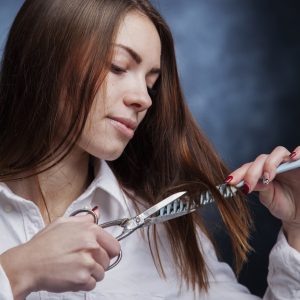
A woman’s haircut will always generate a lot of hair cuttings even if it is only a trim. This has no relevance when you go to the salon for your monthly pampering but if you’re cutting your own hair, it can be a major problem. After all, you’ll have to clean all the mess you create in your bid to look cleaner, neater, more beautiful, and chicer.
This is why it is important to be very careful while choosing where you will cut your own hair. The obvious choice is the bathroom, where you’ll have easy access to water and mirrors. Moreover, the bathrooms are good because you’ll be able to take a shower right after the cut.
Cleaning bathrooms is also easier than cleaning other rooms in your house. Besides, you’ll be sure that hair cuttings don’t get into places where they become very difficult to remove.
While bathrooms are the best place, you can also choose your garden, your terrace, your porch, or your balcony. These places may not have built-in plumbing but cutting your hair there can be a really nice experience.
Wherever you choose to cut your own hair, make sure that you have the setup right. Have fixed or handheld mirrors to help you see what you’re doing on your head. You can get basic mirrors or three-way mirrors. The latter are very helpful because they let you see what you’re doing from three different angles.
Here’s an example of the kind of three-way mirror you should get. Also, be ready with the tools needed to clean up after yourself. Typically, this means an effective vacuum cleaner.
Get the Right Equipment
Professional stylists are very careful about their equipment. Do you know why? The reason is that a professional is only as good as his equipment.
You can be the best and the smartest shopper in the world but if your credit card doesn’t work, you can’t buy anything.Similarly, you can be the most skillful hairstylist in the world but if your scissors are not sharp or your comb not right, you’ll end up with a mess on your head.
The scissors, naturally, are the most important but there are other tools you’ll need to give yourself a nice haircut. We should also add that all tools except for scissors and combs are optional.
While the other tools will make your task easier and your success more assured, it is possible to work without them. We’ll explore all the possible tools in more detail below.
Styling Scissors
As we mentioned above, scissors are critical to cutting your own hair. This doesn’t only mean that you can’t cut your hair without them but also that you need the right type of scissors to get the right cut.
If you’ve been planning to dip into your kitchen drawer for your home scissors, perish the thought. If you try to cut your own hair with those scissors, you’ll be courting disaster. Home or kitchen scissors are neither sharp enough to be precise with their cuts nor designed to be maneuverable.
Firstly, when you try to cut your hair, they’ll push the hair before cutting them. This will lead to uneven cuts. Moreover, it can also result in frayed and split ends. Not only will home scissors ruin your efforts but the results will be very difficult to fix for a beginner like you.
What you need are styling scissors. Styling scissors are specifically made to be extremely sharp so that they can cut hair with precision and accuracy. The precision comes from the fact that they have little rings through which you can insert your finger and thumb.
These rings will make a huge difference and offer greater maneuverability as you move the scissors around your head. Once you use styling scissors, you will realize how much more manageable and easier-to-use they are when compared to home scissors.
Styling Comb
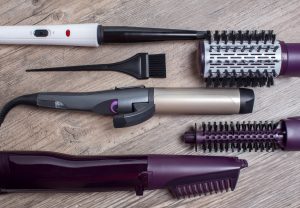
Your need for a styling comb will depend on the technique you’re using to cut your own hair. If you’re confident about your haircutting abilities then you’ll want the increased control and subtlety of the traditional methods of cutting hair. You can’t use these methods unless you have a good styling comb.
A styling comb is divided into two halves. One has widely-spaced teeth and the other has tightly-spaced teeth. If you’re going to be using traditional methods of cutting your hair, you’ll need both wide and tight-toothed sides.
On the other hand, the styling combs are not required for hair cutting techniques that use ponytails, pigtails, or even twisting hair. You’ll be choosing from these trending, modern, and simpler techniques if you want an easier and quicker fix for your overgrown hair.
While styling combs may not be important with these nifty, shortcut types of haircutting techniques, we still suggest you get one for two reasons. The first is that they are very helpful if you’re trying to finetune your haircut and the other is that they barely cost anything. Of course, a styling comb is much better for brushing and detangling hair than your generic everyday comb or brush.
Section Clips / Hair Ties
If you’re going to cut your own hair, you’ll need some way of managing your hair. This means either section clips or hair ties.
Hair ties and elastic bands are critical for techniques that require you to tie your hair such as those that use ponytails and pigtails. Section clips such as alligator clips are very helpful when it comes to securing hair sections up and away from where your hands are working. Of course, they can be used to hold ponytails and pigtails too.
As is obvious, your job will be easier if you have both – hair ties for ponytails or pigtails and section clips for hair sections.
Barber’s Cape
A barber’s cape isn’t the most necessary thing if you’re planning to cut your hair. This is especially true if you’ve decided to do it in the bathroom. You can take a shower after the cut to get rid of hair cuttings.
However, if you’re going to be cutting your hair in other parts of your house, then we advise using a barber’s cape since it will keep things neat. If you choose the fabric or design of the cape right, the cape may even keep most of the hair cuttings from reaching the floor. Whatever type you pick; the cape will protect your upper body from the hair cuttings.
Spray Bottle
The spray bottle is another tool that isn’t completely necessary to cut your own hair but can ease the way for you. It is needed to gently spritz the hair and keep it damp since the hair can dry up in the middle of the cutting process.
Of course, you can always splash some water in your hair by hand or a hand shower, but it is better to use a spray bottle because of two reasons. The first is that the spray is gentle and doesn’t move the hair much and the other is that it will make the hair damp instead of wet. Wet hair isn’t as manageable as damp or dry hair.
Choose if You Want to Cut Your Hair Damp or Dry?
Before you get down to cutting your hair at home, you should decide if you want to cut damp hair or dry hair. While the most important factor you need to consider while making this choice is your hair type, you’ll want to take into account your preferences and skill-level as well because both these approaches have their pros and cons.
For instance, it is easier to cut damp hair than dry hair because damp hair stays in place as straight and plain as possible while dry hair can curl or become wavy. However, it is important to remember that hair looks longer when it is wet than when it is dry.
This is one of the reasons why it is very easy to overcut damp hair. So, if you’re choosing to cut your hair damp, make sure you’re very conservative about how much you take off.
On the other hand, if you’re only looking to trim your existing hairstyle, then cutting your hair dry will be a better option, regardless of your hair’s texture or your skill-level. Since you’ll be able to see how your hair is turning out while you’ll be cutting it, you’ll be in more control of the outcome.
If you’re looking for more than a simple trim, though, your choice between damp and dry should take into account how you want to look. If you’re interested in blunt or sleek looks, you’ll want to damp your hair before cutting them. On the other hand, if you want to retain the texture of your hair i.e. its curls and waviness, you’ll be better off cutting them dry.
Finally, always remember that you cannot cut hair with buildup, irrespective of whether it is dust, sweat, or hair products. Your hair needs to be clean for the cut to be smooth and without problems. Therefore, always wash and condition your hair before a cut. If you’re cutting dry, wash, condition, and dry your hair before initiating the cut.
Cutting the Hair at Home
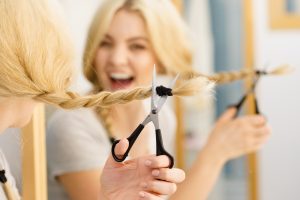
The thumb rule of cutting your own hair at home is that you should always take off less than what you want to. In other words, you have to be conservative in choosing the length of hair you cut off.
The reason is that it is far easier to cut off more hair than to grow more hair. Therefore, if you cut off too much then there is no way you can repair the damage other than to wait. On the other hand, if you cut off too little, you can always revisit the cut to refine it.
In fact, being conservative is something you should practice in other ways as well. For instance, if you’re cutting your hair in sections, it would be wise to shorten one or two sections and then assess whether the length is right before moving onto the other sections.
We also suggest using the point-cutting technique to cut your hair, unless you’re specifically looking for the blunt look. This is a professional cutting technique where the scissors are pointing into the section of hair while cutting the hair. As a result, your scissors are either parallel to the section of your hair or angled instead of being perpendicular as is seen with blunt cuts.
The point-cutting technique can be seen as insurance against mistakes. Mistakes are naturally hidden with the point-cutting technique, while they’re incredibly visible with the blunt cutting technique. You’ll see this most often with your bangs where even the slightest of mistakes can become glaring flaws in your haircut.
Apart from how you wield your scissors, you’ll also have to decide on a specific method to cut your hair. While there are many you can use, we’ve found eight to be the most useful. These are three ponytail methods, the pigtails method, two methods involving twisting of hair, the upside-down method, and the traditional back to front method.
We’ve explained each off these methods in detail below.
The Three Ponytail Methods
The ponytail method is one of the easiest ways of cutting your own hair at home. It neither requires a keen sense of balance and symmetry nor does it demand evolved cutting skills and agile wrists. Further, this method is also the least time-consuming and effort-centric of them all.
However, this doesn’t mean that this method will give you a dull, boring, and simple haircut. On the contrary, it will deliver layers. The best part is that you’ll be able to choose where you want those layers.
There are three variants of the ponytail method. These vary based on the position of your ponytail i.e. the low, the high, and the front. Choosing from these three variants will also decide where the layers will be in your hair.
The low ponytail i.e. making a ponytail closer to the nape of your neck will result in a straight hairstyle with a slight rounding at the back. The rounding is slight because the layers created by this ponytail positioning are very subtle.
The high ponytail, on the other hand, will give you more prominent layers. The layers will begin from the top and will give your hair a distinct U-shaped appearance. A high ponytail means that your hair is tied at the crown of your head.
If you make the ponytail at the top of your forehead, near your hairline then you’ll get a more V-shaped hairstyle with a great deal of distinguishable layering. However, the most important aspect of the front ponytail method is that it will give you layers to frame your face.
Apart from the actual position of the ponytail, the three variants of the ponytail method aren’t all that different. Even so, this doesn’t mean that you don’t need to stick to a defined roadmap. To help you along, here’s a step by step process.
- Make sure your hair is clean by washing it. If you’ve recently washed it, then simply make it damp with a spray bottle. However, if you’re using the front ponytail method, you don’t need to make your hair damp.
- The Low Ponytail Method: Part your hair in the middle very carefully. Use the wide-toothed side of your comb to part your hair and remove tangles. Refine the parting you’ve created with the fine-toothed side of your comb. Try to be as accurate as possible and make sure the part is not crooked or bending in any one direction. Make the ponytail at the nape of your neck, below the hairline.
- The High Ponytail Method: Bend over from the waist and hang your head straight towards the floor. You can avoid bending over and make the ponytail standing up, but it will be considerably more difficult to get the position of the ponytail right that way. While bending down, brush down your hair and remove all tangles. Make the ponytail and make sure that it is as close to the scalp as possible.
- The Front Ponytail Method: This is a dry haircut because you need your hair to be in its natural state and wetting it will make it seem longer than it normally is. Bend over at the waist and drop your head towards the ground. Brush away kinks and tangles to make your hair straight, before making a ponytail near your hairline at the top of your forehead. The location of the ponytail is one of the reasons why this method is also called the unicorn cut.
- The ponytail needs to be as clean as you can make it. Pull the hair away from the scalp and ensure the hair is tight and without bumps before tying it with your hair ties. Also, make sure the ponytail is in the center. Low ponytails need to be right in the middle of your neck, the high ponytail needs to be at the topmost part of your head, and the front ponytail needs to be straight above your nose.
- Regardless of which method you’re employing, you’ll need to put another hair tie in your ponytail. This second hair tie will be just above the spot you want to cut your hair. Choose this spot conservatively to be safe. You can always cut another level higher if you’re not entirely happy with the cut. In the case of the front ponytail method, put the second hair tie around the spot you want your shortest (first) layer to be. Chin-length is usually the best place to begin.
- You can now shorten the ponytail. Hold the ponytail tight and cut away the excess. Make sure that you don’t try to snip all the hair at one go. Irrespective of how sharp your scissors are, they won’t be able to handle so much hair. Either flatten the tip of the ponytail and snip away slowly or simply cut in smaller portions till you’ve gone through the entire width of the ponytail.
- Women using the high and front ponytail methods will have an extra step. You need to take the blunt end of the ponytail and use the point-cutting technique on it until the ends of your hair look like a shaving brush. This is required because the blunt look doesn’t work as well with layers as it does with straighter hairstyles.
The Two Twisting Hair Methods
Even though the ponytail methods are better for women who prefer their hair long, you can still use them for shorter haircuts. All you need to do is take off more hair. The only problem is that short-length hairstyles aren’t all that great at highlighting layers.
Since layers don’t show so easily in short-length hairstyles, they need to be bolder. While you can always start conservatively with your short hair i.e. the ponytail methods, if you’re open to being more aggressive, you can try the twisting hair method.
The twisting hair methods are particularly great for shorter hair because they deliver styles that are not very common. There are two twisting hair methods of cutting your own hair. One delivers an angled hairstyle like the inverted bob, while the other can be used to create the pixie cut.
The first twisting hair method will not result in significant removal of hair and will only create an angling look. The second twisting method, however, will result in considerable removal of hair and weight off your head. This is understandable too since you’ll be consciously deciding to take off a lot of hair. This is exactly why the second method isn’t a great option for women with thin or fine hair.
Here are the steps for both these twisting hair methods.
- Start by combing your hair away from the scalp. Bending from the waist will make this task easier since you won’t need to stretchy out your arms to hold your hair straight above your head. Use a wide-toothed side of the comb before switching to the thinner side to take away all the tangles.
- If you’re going for the pixie and want bangs, section off the bangs before the next step. Decide on the length and type of bangs you want before sectioning them off.
- Once your hair is brushed properly, stand straight and twist the ends of the hair. Make sure the hair is tight in the twist and no strays are left behind.
- Use your styling scissors to cut the length of hair you want removed. It is very easy to cut off more than you planned when using this method. Therefore, remember to be conservative.
- One of the ways of getting a good sense of how your hair will look is to test it out. To do this, take a section of hair from the twist and see how low it falls in relation to your face. It is better to pick a section in the front so that you get a sense of how long your shortest layer is going to be. The pixie cut, of course, will need your hair to be short. Remember to put the section of hair back into your twist before using the scissors.
- Once cut, you can let the twist go. Your hair will fall back down. You’re still not done with the cut. Comb or brush down your hair and then create another twist. Make sure this twist is in the opposite direction to the earlier one. This will reveal strays that will need to be snipped off. Remove the strays and you’re done with the inverted bob.
- For women who want the pixie cut, the process is still not complete. You’ll have to refine your hairstyle now. To do this, start by combing your hair down and sectioning them. Make sure the sections are thin and light.
- Take one section and use the point-cutting technique to take away the blunt look. Follow through section by section till you’ve covered all your hair.
- The final step will be to take care of your bangs. If you’re okay with blunt bangs, simply comb them down and snip away horizontally. However, if you want lighter, wispier bangs, then you’ll have to use the point-cutting technique on your bangs too.
The Pigtails Method
In essence, the pigtails method is like the ponytail method. After all, pigtails are nothing but two ponytails on the side of the head instead of at the back. There are two things you need to remember when it comes to this technique, though.
The first is that this cutting technique will take away a lot of length and weight from your hair. Therefore, if you have fine or thin hair, then this technique may not be the best for you. The other is that this technique will leave the back of your hair in a V-shape i.e. your hair will taper into a point. You’ll, of course, have the option of modifying this look if you want.
Here’s the process in a step-by-step format.
- You need your hair to be clean for this technique. So, wash your hair in advance or make it damp if you washed it earlier. Also, you need the hair to be straight to use this technique. So, use a flat iron to straighten out your hair.
- Use the fine-toothed side of your comb to create a part right in the middle of your scalp. This part will run from your forehead to the nape of your neck and needs to be as straight and pure as you can make it. You should strive for this even if it means parting your hair multiple times before you get it right. You’ll also have to detangle your hair. Use both the fine and wide sides of your comb to do this.
- Use hair ties to tie the two halves of your hair into pigtails. The position of the hair ties needs to be just below and behind your ears. Once the hair ties are in place, you need to tighten the pigtails. To do this, split a pigtail into two below the hair tie. Hold one in each hand and gently pull them away from each other. You’ll see your hair tie moving upwards. Do this to both the pigtails till you feel they’re tight enough.
- Now you need to decide how much hair you want to remove before pushing the hair tie just above that point.
- You’re now ready to cut your hair but you have to be careful about how you do that. Simply snipping away horizontally will result in a very abrupt and blunt cut. We advise cutting at an angle of 45 degrees with the scissors pointing upwards.
- You can open your pigtails now. Brush down the hair to help them merge better and you’ll get the V-shape.
- If you don’t want the V-shape and prefer a slightly layered or blunt look, use the ponytail technique. Tie your hair into a low ponytail and snip off the end. This will take away the V-shape look.
- If you don’t want a blunt look, use the point-cutting technique to give the back of your hair more character.
The Upside-Down Method
Even if you follow one of the haircutting techniques already mentioned above, you may need to work on your hair further to even out problem areas. This will mean cutting your hair in the simplest way and without any tying tricks.
One way to circumvent this problem is to cut your hair without the tying tricks from the beginning itself. This means the traditional way of cutting hair. However, the traditional way is not very easy and can lead to more mistakes as you’ll see when we describe the process in the next section.
An easier version of the traditional method of cutting the hair is the upside-down method. This method will not deliver elaborate hairstyles unless you’re willing to take serious risks but it will give you a simple hairstyle and will keep you from looking unkempt and untidy.
Here’s the process behind this technique.
- Wash and clean your hair. If you’ve just washed your hair, then start this process before they dry up completely. 80 to 90 percent dry is good to start with. If your hair is already dry, spritz some water into it from a spray bottle to make it damp. Remember, be conservative when cutting wet hair. When your hair will dry, it will look shorter than what it looked like while wet.
- Comb your hair with both the wide and fine-toothed sides of the comb to smoothen it. This will remove tangles too. Do this standing up, then bend over at your waist and do it again.
- Moving from one side to the other, start evening out your hair in smaller sections. Make sure that you employ the point-cutting technique unless you’re categorically going for the blunt look.
- If you wish, you can use hair ties or clips to keep sections apart but we advise against doing this. Keeping sections apart is not a good idea because it will deprive you of much-needed guides. The trick is to cut one section, and then take a bit of hair from that section into the next one to act as a guide.
- Once you’re done cutting and evening your hair, you should brush it all down again, and analyze your cut. Repeat the entire procedure if you feel corrections are needed.
The Back to Front Method
This is the haircutting method is the closest to the traditional technique, where you go from one section to another to get your cut. It also happens to be the best option for women with very long hair.
This technique is neither the easiest nor the most difficult, but it is a little time-consuming because it requires you to make multiple ponytails and cut each individually. At the same time, this haircutting technique is one of the more versatile ones because it gives you more control over your layers.
Since you’ll be cutting multiple ponytails, you’ll have the option of layering each of them differently. Unfortunately, this also means that there’s more scope for mistakes with this method. To avoid them, we suggest a dual-mirror setup. The dual-mirror setup sees two mirrors facing each other with you in the middle.
Despite the difficulty, this method offers a more nuanced outcome than any of the other cutting methods. It’s a matter of risks vs. rewards. So, consider carefully before trying this one out. Our suggestion is to only attempt this method if you have some experience of cutting your own hair.
In other words, cut your own hair two to three times with the simpler techniques, before trying this one. On the other hand, if you think you’re ready, there’s no time better than now.
Here is a step-by-step guide for the back to front method of cutting your own hair.
- Wash and clean your hair. This is a damp haircutting method so if you’ve just washed your hair, let it dry until it is around 85 percent wet. If your hair is already dry, make it damp with a spray bottle.
- Comb your hair thoroughly to detangle and straighten it. Use both the wide and fine-toothed sides of your comb. It would also be a good idea to create a middle partition as that will help you with the next step.
- You’ll have to make at least eight sections for this haircutting method, encompassing your entire scalp. However, if you have thick hair, then you may need more. You will be making one section for bangs, one at the back located near the nape of the neck, and two each for the front, back, and sides. As you make each section, twirl it around a finger, before tying it with a hair tie and clipping it up.
- If you have long hair, make the ponytail lose with the hair tie placed around the nape of the neck but if you have short hair, make the ponytail tight and closer to the scalp. Also, leave the section at the nape of your neck unclipped, since this is the section you’ll be beginning with.
- To cut a section, run your ponytail between your index and middle finger till you reach the point at which you want to cut. You need to do this to stretch the section and make it smooth.
- The angle at which you hold the scissors to the ponytail will define the final look. A perpendicular cut will create a blunt look, a 45-degree cut will give you natural-looking layers, and a 90-degree cut will deliver a very fine, wispy look.
- Follow through with the rest of the sections, moving from back to front until you’ve cut all of them. The 90-degree cut is the one you should be using on your bangs or they’ll look artificial. Also, cut your bangs last to give them time to dry up. Wet bangs will seem longer than normal and you may be fooled into cutting more than you should.
- To finish the cut, comb and check each section again for strays. Snip them off and you’re done. Review the results and then consider modifications. You can follow the same steps and cut the sections at different lengths for an even more natural layered look.
